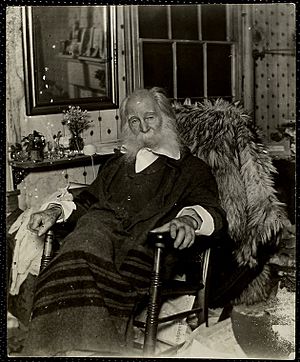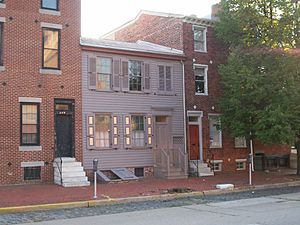Walt Whitman House facts for kids
|
Walt Whitman House
|
|

Walt Whitman House in Camden, New Jersey
|
|
| Location | Camden, New Jersey |
|---|---|
| Built | circa 1848 |
| NRHP reference No. | 66000461 |
Quick facts for kids Significant dates |
|
| Added to NRHP | October 15, 1966 |
| Designated NHL | December 29, 1962 |
The Walt Whitman House is a historic building in Camden, New Jersey, United States. It was the last home of the famous American poet Walt Whitman. He lived here during his later years until he passed away. The house is located at 330 Dr. Martin Luther King Jr. Boulevard. In Whitman's time, this street was known as Mickle Street.
Contents
A New Home in Camden
In 1873, Walt Whitman became very ill, which made it hard for him to move. In May of the same year, his mother, Louisa Whitman, also passed away. These events made him feel very sad. Whitman had been living in Washington, D. C., but he soon moved back to Camden, New Jersey. He went to live with his brother, George, and stayed with him for eleven years on Stevens Street.
Buying His Own Place
In 1884, when he was 65 years old, Whitman bought his very first home. This was the Mickle Street House in Camden. He often called it his "shanty" or "coop" because it was quite old and simple. His brother George did not like the idea of him buying such a house, and it caused some tension between them. Other friends also wondered why Whitman chose this house. One friend even said it was "the worst house and the worst situated."
The land where the house stands was bought in 1847. The house itself was likely built around that time. When Whitman bought it, it was a two-story house with six rooms. It did not have a furnace for heating. Whitman bought the house for $1,750. He got this money from selling a new edition of his famous book, Leaves of Grass, and from a loan.
Life in the House
Whitman invited Mary Davis, a sailor's widow, to be his housekeeper. In return, she could live in the house for free. She moved in on February 24, 1885. Mary brought many pets with her, including a cat, a dog, two turtledoves, and a canary.
Many people visited Whitman at his Camden home. In 1882, the famous writer Oscar Wilde came to see him. They shared elderberry wine, and Wilde later said he loved and honored Whitman very much. Another visitor, John Johnston, described meeting Whitman on a hot summer day in 1890. He saw the poet sitting in a rocking chair with his shirt open and sleeves rolled up.
While living in this house, Whitman wrote several new poems. Many of these poems were about important public events. For example, he wrote a poem in 1885 about the completion of the Washington Monument. Whitman often wrote in his bedroom, which visitors said looked like a newspaper office because it was full of stacks of paper. He also put together a collection of his writings called November Boughs in this home.
During these years, Whitman did not earn much money from his books. Most of his income came from gifts and donations from his admirers and friends.
Whitman's Final Years
Whitman's health got worse over time. He had another serious illness in 1888. He started to prepare for his death. He paid $4,000 to have a special granite tomb built for himself. He often visited it while it was being built.
In his last week of life, Whitman was very weak. He wrote about his constant pain. He spent his final years working on the last edition of Leaves of Grass. At the end of 1891, he wrote to a friend that the book was "at last complete" after 33 years of work. In January 1892, an announcement was published saying that this new 1892 edition should replace all earlier ones. This final edition of Leaves of Grass is often called the "deathbed edition."
Whitman passed away on March 26, 1892, just a few days before his 73rd birthday. His body was viewed by over a thousand people at his Camden home. In his last years, Whitman had grown to love Camden and his house. He wrote that moving to Camden was an "accident" but that it had brought him "blessed returns."
The House Today
After Whitman's death, most of his belongings stayed in the house. In 1921, his heirs sold the house to the city of Camden. Five years later, it was opened to the public as a museum. In 1947, the state of New Jersey took ownership of the house.
The Walt Whitman House is now a museum run by the New Jersey Division of Parks and Forestry. It is open to the public, and the Walt Whitman Association helps to operate it. Inside, you can see the bed where the poet passed away and the notice that was taped to his front door after his death.
See also
- National Register of Historic Places listings in Camden County, New Jersey
- List of museums in New Jersey
- Walt Whitman Birthplace State Historic Site in New York
- List of residences of American writers






